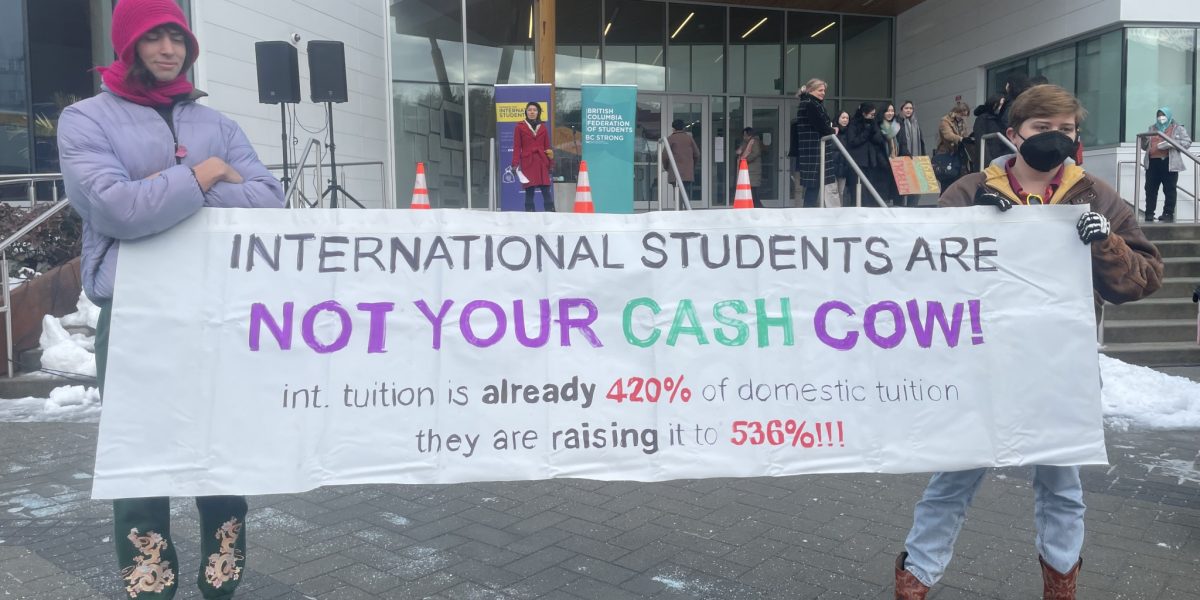As a former international student in the UK, the start of the academic year is a reminder of the outrageous ‘overseas student’ fees I had to pay, which are often two to three times that of a domestic student, as well as student debt that I will never fully pay off. Conversations about unregulated tuition fees set by universities, bleak housing options, and low employment opportunities for international students are certainly not new, but the outlook for students has continued to worsen since I was an international student.
In particular, the global snapshot of the international student housing crisis reads from the privatization playbook. Large private investors have snapped up purpose-built student housing, viewing the properties as hot assets and immiserating international students. As a result, an increasing numbers of international students across Canadian cities like Toronto and Calgary are facing homelessness, nights spent in tents, unsafe housing and precarious employment just to cover rent.
The precarious housing situation for international students is often coupled with predatory third-party immigration fees in home countries, which mean that international students often take on massive debts to afford an education even before they step foot in Canada.
The complex private systems involved in the process often lead to real exploitation and harm. This was exposed most recently through the deportation orders against 800 former international students in Canada, who were scammed by admissions agents in their home country and not protected by institutions in Canada. While their deportation was eventually halted, largely due to collective action and organizing, the precarity that international students continue to navigate remains present during and even after their studies as they wait for permanent status and decent work.
Particularly for international students, growing anti-immigrant sentiments, lack of social networks, and temporary immigration status means that they are more vulnerable in the housing market than the average Canadian resident and are therefore more likely to be victims of a growing number of housing scams. Overall, it is clear that uncertainties that international students face while paying exorbitant fees to higher education institutions sits in stark contrast to the economic benefit that universities and colleges and the Canadian economy reaps from international student fees.
Student housing crisis an extension of a wider problem
With the cost of housing relative to income quickly rising in cities across Canada, the lack of affordable student housing is a specific part of a wider problem. While an increasing number of homes and housing have been built in the past three years alone, this has not meant an increase in affordable and safe housing, especially for international students.
There is no requirement by provincial or federal governments to make higher education institutions build housing proportional to the number of students admitted each year, resulting in a chronic shortfall that forces students into a poorly regulated private market. For instance, in the University of Manitoba, there are more than 26000 students bidding for an average of 1,100 residences on campus.
Student housing, like all housing, must be treated by governments and universities as a human right, and not as a commodity. In the book Tenant Class, Ricardo Tranjan draws parallels between exploitative labour relations and the exploitative rental market to explain what the housing crisis really is: an extractive and poorly regulated market, where predatory landlords and real estate firms are able to amass wealth on the backs of tenants and working people.
This contrasts with the dominant view that the ‘housing crisis’ as a simple supply problem that can be remedied by further preferential treatment of the landlords and developers by the government in the hope of incentivising home building and decreasing prices. While supply issues are real, it is not the whole story.
The result is that a network of higher education institutions, landlords, aggressive financial investors, and international recruitment agents are further able to amass profit and benefit from the disproportionate exploitation of groups like international students. For example, the most recent intervention from the government has come in the form of a proposal to limit the number of international students permitted in Canada. This does not address the housing crisis; it absolves the landlord class of accountability and fans the flames of xenophobia, discrimination, and hostility that immigrants are exposed to in Canada.
A history of profiteering off international students
Even when the Ontario government announced an extension of the domestic tuition freeze for the 2023-2024 academic year in 2022, the freeze was not extended to international student fees. Differential pricing and the increased precarity of international students was institutionalized starting 1977 when provinces began to deregulate international student tuition and left it up to post-secondary institutions to set their own rates.
At the same time, the federal government was cutting corporate tax rates to convince businesses to come to the country. All of this resulted in a decrease in public funding for international student’s education and a rise in private colleges and university-college partnerships, which often lack the infrastructure and capacity to deliver academic programming and affordable housing options. Over time, the increase in international students and their significant contribution to Canada has not been met with a proportionate increase in resources and protections for them.
Available data from StatsCan suggest that even after the pandemic, universities across Canada raked in one of the highest surplus revenue amounting to $7.3 billion during the 2020-21 fiscal year and international student fees made a significant contribution to the surplus. While Statistics Canada does not record disaggregated data around tuition contribution by international students to their institutions, data from 2020 suggest that universities relied on international student fees to cover close to half of its total revenue collected from fees. In the same context, international students only make up 17 percent of students studying in Canada.
As universities and colleges face greater pressure from students, media, and the public about student housing and the lack of support in place for international students, these institutions look to the federal government to build housing and step-in. While the government has a big role to play in the regulation of international student tuition fees, provisions of affordable housing and removing barriers to permanent status and employment after graduation, universities and colleges also have a responsibility toward the students they aggressively recruit for profits.
Race, status and precarity
A crucial element in the experience of the international student housing crisis and related vulnerability is tied to race, class, and immigration status. For instance, the majority of the University of Toronto’s international tuition fees come from the Global South. International students say that the crisis of housing and working precarious jobs alongside their studies is common for them and many of their racialized peers.
Vulnerabilities linked to immigration status and race also play out after their studies while seeking decent work. According to a 2021 Statistics Canada study, international students earn less than their domestic counterparts post-graduation and experience lower employment outcomes.
Factors that contribute to this include employers’ reluctance to hire applicants with temporary residency status and limited work experience in Canada forcing graduates to take up employment under unsafe and exploitative conditions as they work towards permanent residency. Like tuition fees and housing options, international students’ path to permanent status remains unregulated and uncertain.
Movements that are able to draw these links between immigration status, right to housing and racism to demand better of private and public institutions are essential to coordinate a response to the student housing crisis. The organizing capability and success of racialized migrant students was demonstrated earlier this year when over 700 international students stopped their deportations as victims of immigration fraud. In addition to putting pressure on the government on all fronts, it is also essential to push higher education institutions to provide transparent information to international students prior to their arrival, and adequately invest resources into infrastructure and services such as building housing, providing academic support and investing pathways for employment, instead of lining their pockets.
Did you like this article? Help us produce more like it by donating $1, $2, or $5. Donate


